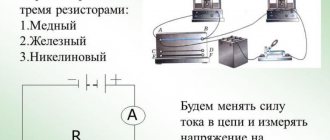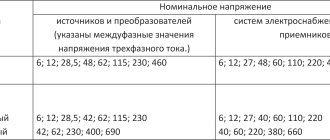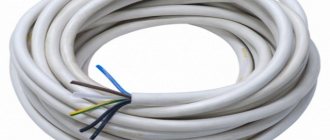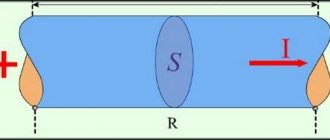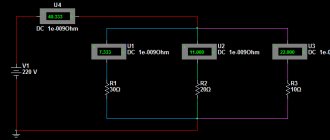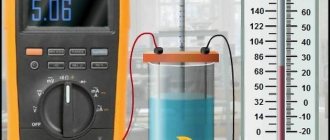Dependence of conductor resistance on temperature
Specific resistance, and therefore the resistance of metals, depends on temperature, increasing with temperature. The temperature dependence of conductor resistance is explained by the fact that
- the intensity of dispersion (number of collisions) of charge carriers increases with increasing temperature;
- their concentration changes when the conductor is heated.
Experience shows that at temperatures that are not too high and not too low, the dependences of resistivity and conductor resistance on temperature are expressed by the formulas:
ho_t = ho_0 (1 + alpha t) ,) (
R_t = R_0 (1 + alpha t) ,)
where ρ
0,
ρ
t are the specific resistances of the conductor substance at 0 °C and
t
°C, respectively;
R
0,
R
t - conductor resistance at 0 ° C and
t
° C,
α
- temperature coefficient of resistance: measured in SI in Kelvin minus the first power (K -1). For metal conductors, these formulas are applicable starting at temperatures of 140 K and above.
Temperature coefficient
The resistance of a substance characterizes the dependence of the change in resistance when heated on the type of substance. It is numerically equal to the relative change in resistance (resistivity) of the conductor when heated by 1 K.
mathcal h alpha mathcal i) - average value of the temperature coefficient of resistance in the interval Δ T
.
For all metal conductors α
> 0 and varies slightly with temperature.
For pure metals α
= 1/273 K -1.
In metals, the concentration of free charge carriers (electrons) is n
= const and the increase in
ρ
occurs due to an increase in the intensity of scattering of free electrons on ions of the crystal lattice.
For electrolyte solutions α
-1 . The resistance of electrolytes decreases with increasing temperature, since the increase in the number of free ions due to the dissociation of molecules exceeds the increase in the dispersion of ions during collisions with solvent molecules.
Formulas for dependence ρ
and
R
versus temperature for electrolytes are similar to the above formulas for metal conductors.
It should be noted that this linear dependence is preserved only in a small temperature range, in which α
= const. At large temperature ranges, the dependence of the electrolyte resistance on temperature becomes nonlinear.
Graphically, the dependences of the resistance of metal conductors and electrolytes on temperature are shown in Figures 1, a, b.
At very low temperatures, close to absolute zero (-273 °C), the resistance of many metals abruptly drops to zero. This phenomenon is called superconductivity
. The metal goes into a superconducting state.
The dependence of metal resistance on temperature is used in resistance thermometers. Usually, platinum wire is used as the thermometric body of such a thermometer, the dependence of whose resistance on temperature has been sufficiently studied.
Temperature changes are judged by changes in wire resistance, which can be measured. Such thermometers allow you to measure very low and very high temperatures when conventional liquid thermometers are unsuitable.
Resistance
The current strength in a conductor depends not only on the voltage of the electric field in it.
It also depends on the conductor itself: on its shape, size, and on what material it is made of. At the same field voltage, the currents in different conductors will be different. Let's take a piece of copper wire 100 meters long with a cross-section of 4 square millimeters. Let's create a voltage of one volt at the ends. The ammeter will show in this case a current of 2.2 amperes.
At the same voltage, in the same piece of iron wire, the current will be only 0.44 amperes, and in the same wire, but made of nichrome (an alloy of nickel, iron and chromium) - only 0.03 amperes.
Copper, iron and nichrome have different electrical resistance. The resistance of copper is low, that of iron is greater, and that of nichrome is very high.
Resistance depends not only on the material of the conductor, but also on its shape and size. A thick wire has less resistance than a thin wire, and a long wire has more resistance than a short wire. To understand why this is so, we need to find out what causes the resistance of conductors to electric current. We will talk about this further.
The unit of resistance is the resistance of a conductor in which a voltage of one volt creates a current of one ampere. This resistance is called one ohm.
So, the current strength in a conductor depends on the field voltage at its ends and on the resistance of the conductor. The higher the voltage, the greater the current. The greater the resistance, the less current.
To find out what the current strength is, you need to divide the voltage created by the field at the ends of the conductor by the resistance of this conductor.
In practice, the current strength is usually not calculated, but measured with an ammeter. Voltage is also measured. And knowing the voltage and current, it is not difficult to calculate the resistance of the conductor.
Since voltage force current = voltage / resistance, THEN
resistance = voltage / current,
On the terminals of the arc lamp shown in Fig. 12, a voltage of 55 volts is created. A current of 5 amperes flows through the arc. This means that the resistance of the burning arc is equal to
55 / 5 = 11 ohms.
Not only metals, but also all other bodies have electrical resistance.
The resistance of insulators (quartz, rubber, glass, porcelain, etc.) is especially high. If there were absolutely no free charges (electrons, ions) in insulators, then their resistance would be infinite. The highest voltage would not cause current in the insulators.
In fact, such ideal insulators do not exist. In any insulator there is a small number of electrons and ions that have escaped from their places. Therefore, in insulators, when a field is applied, a current arises.
Dependence of conductor resistance on temperature
Specific resistance, and therefore the resistance of metals, depends on temperature, increasing with temperature. The temperature dependence of conductor resistance is explained by the fact that
- the intensity of dispersion (number of collisions) of charge carriers increases with increasing temperature;
- their concentration changes when the conductor is heated.
Experience shows that at temperatures that are not too high and not too low, the dependences of resistivity and conductor resistance on temperature are expressed by the formulas:
ho_t = ho_0 (1 + alpha t) ,) (
R_t = R_0 (1 + alpha t) ,)
where ρ
0,
ρ
t are the specific resistances of the conductor substance at 0 °C and
t
°C, respectively;
R
0,
R
t - conductor resistance at 0 ° C and
t
° C,
α
- temperature coefficient of resistance: measured in SI in Kelvin minus the first power (K -1). For metal conductors, these formulas are applicable starting at temperatures of 140 K and above.
Temperature coefficient
The resistance of a substance characterizes the dependence of the change in resistance when heated on the type of substance. It is numerically equal to the relative change in resistance (resistivity) of the conductor when heated by 1 K.
mathcal h alpha mathcal i) - average value of the temperature coefficient of resistance in the interval Δ T
.
For all metal conductors α
> 0 and varies slightly with temperature.
For pure metals α
= 1/273 K -1.
In metals, the concentration of free charge carriers (electrons) is n
= const and the increase in
ρ
occurs due to an increase in the intensity of scattering of free electrons on ions of the crystal lattice.
For electrolyte solutions α
-1 . The resistance of electrolytes decreases with increasing temperature, since the increase in the number of free ions due to the dissociation of molecules exceeds the increase in the dispersion of ions during collisions with solvent molecules.
Formulas for dependence ρ
and
R
versus temperature for electrolytes are similar to the above formulas for metal conductors.
It should be noted that this linear dependence is preserved only in a small temperature range, in which α
= const. At large temperature ranges, the dependence of the electrolyte resistance on temperature becomes nonlinear.
Graphically, the dependences of the resistance of metal conductors and electrolytes on temperature are shown in Figures 1, a, b.
At very low temperatures, close to absolute zero (-273 °C), the resistance of many metals abruptly drops to zero. This phenomenon is called superconductivity
. The metal goes into a superconducting state.
The dependence of metal resistance on temperature is used in resistance thermometers. Usually, platinum wire is used as the thermometric body of such a thermometer, the dependence of whose resistance on temperature has been sufficiently studied.
Temperature changes are judged by changes in wire resistance, which can be measured. Such thermometers allow you to measure very low and very high temperatures when conventional liquid thermometers are unsuitable.
Liquids
Current conductors in a liquid are anions and cations that move due to an external electric field. Electrons provide little conductivity. Let's consider the dependence of resistance on temperature in liquids.
Where:
- Electrolyte
- Battery
- Ammeter
The dependence of the effect of electrolytes on heating is prescribed by the formula:
Where a is the negative temperature coefficient.
How R depends on heating (t) is shown in the graph below:
This dependence must be taken into account when charging batteries and batteries.
Tolerance class
The data below corresponds to international and Russian standards. It is permissible to use unique temperature ranges approved in the specifications of a specific manufacturer.
Tolerances
| Classification according to GOST | Permissible deviation, °C | Standardized temperature range for different types of vehicles (minimum/maximum in °C) | ||
| Platinum wire (film) | Copper | Nickel | ||
| AA | ±(0,1 + 0,0017) | -50/+250 (-50/+150) | — | — |
| A | ±(0,15 + 0,002) | -100/+450(-30/+300) | -50/+120 | — |
| IN | ±(0,3 + 0,005) | -196/+660 (-50/+500) | -50/+200 | — |
| WITH | ±(0,6 + 0,01) | -196/+660 (-50/+600) | -180/+200 | -60/+180 |
Kinds
A conductor is a medium or object that is capable of conducting electric current. Inside it, when connected to an energy source, a charged particle begins to actively move. An ammeter shows the increase in electrical voltage in a circuit. When considering different types of conductors, the electrical conductivity and type of material are taken into account:
- copper;
- aluminum;
- metal;
- gold;
- an alloy of nickel and chromium.
You might be interested in this: Features of the power supply project
In the scientific community there is the concept of a superconductor, which is considered ideal. It has a significant dielectric loss angle. When current flows from a circuit, the percentage of bias is taken into account. For a superconductor, this parameter is minimal.
From copper
Copper belongs to the components of group 11 from the table of chemical elements. According to the classification, it is lamellar and is found in different types. Often the substance has a pink tint. In electrical engineering, copper has a low resistivity and shares a niche with silver and gold.
Silver and gold
The material is applicable in the manufacture of wiring and printed circuit boards. Another substance is in demand in the manufacture of electric drives. Considering complex controlled electromechanical systems, it is noticeable that they use windings with low resistivity.
If we evaluate power transformers, they also use this metal, but it is often used with impurities. This is necessary to reduce the electrical conductivity rate. In printed circuit boards, copper is used in tandem with aluminum. When considering radio components, copper-based alloys, which are also characterized by low resistance, remain in demand.
When disassembling personal computers, the substance is found in bronze or brass. Zinc or nickel additives are also used. To increase the elasticity of the conductor, other materials are used, such as tin and zinc. According to the resistivity table, the substance is assigned an indicator of 0.0157 Ohm.
Properties of copper
Made of aluminum
Among the elements of group 13 in the table, aluminum stands out. It is an excellent conductor in a circuit and is made of paramagnetic metal. The color has a silvery tint. The conductor lends itself well to mechanical processing. In addition to significant electrical conductivity, corrosion resistance is noted.
During heat treatment, an oxide film is formed that protects the surface. There are various aluminum compounds found in nature. If we consider standard wire of small cross-section, it is in demand in electric coils. The substance has low density and mass, so analogues are difficult to find. Using aluminum in moving parts can improve their performance.
The conductor is often found in hard drives and audio systems. Wires coated with a layer of varnish remain in demand. There are enameled analogues that are characterized by increased security. Rubber and beryl are used as insulation. Manufacturers produce conductors with a cross section of 0.003 mm.
Properties of aluminum
In addition to inductors, wire can be installed in inductors, loudspeakers, and headphones. Regarding connections, there are options with alunites. Additional information about physical properties:
- low melting point;
- high heat capacity;
- significant hardness;
- weak paramagnetic;
- wide temperature range.
You may be interested in this: How to calculate grounding
Aluminum is found in printed circuit boards because it can be stamped. Corrosion resistance is an added benefit. Aluminum conductors are popular and in demand in industry. Resistivity - 0.028 Ohm. It is also necessary to consider the disadvantage of a significant content of impurities.
Made of metal
Among metals, the following are considered common types of conductors:
- lead;
- tin;
- platinum;
- nickel;
- tungsten.
Lead is a group 14 element that can be used as a conductor. It has a maximum density of 11.35 grams per cubic meter. The scope of application is limited because the material is toxic and belongs to heavy metals. The history of the origin of the formula is unclear, there are only guesses.
Metal groups
If we talk about conductor elements, lead nitrate is often used. In power sources and backup units there is a version with chloride. Considering inorganic compounds, the material that stands out is telluride. It is suitable as a thermoelectric conductor and is therefore used in power plants of various capacities. The metal element is also in demand in refrigerators.
If we consider telluride in detail, a significant dielectric constant should be attributed to one of the features. In addition to lead, it contains tin and tellurium. Separately, the substances are found in photoresistors and diodes. If you disassemble semiconductor devices, the elements are contained in stabilizers and indicate the direction of current.
Important! Tin is a conductor from group 14 of chemical elements. The material is safe and does not contain toxic substances.
Along with gold, tin has excellent anti-corrosion properties. Disulfide is often used in technology. Tin dioxide shows the highest resistance value. In batteries it is used in its pure form. When considering galvanic cells, it is worth mentioning manganese-tin dioxide.
Platinum is a conductor from the tenth group of chemical elements. The presented metal has an electrical resistance of 0.098 Ohms and is characterized by increased density. If we consider the scope of application, the substance is often found in laser technology. We are talking about printers, as well as measuring instruments.
Properties of platinum
Additionally, platinum is used in electromagnetic relays. In the presented automatic devices it acts as a conductor. We are talking about mechanical, thermal or optical relays. In electronic sensors, platinum is contained in smaller quantities, but is used due to its wide temperature range. In particular, you can consider an electronic resistance thermometer. The resistive element is mostly made of platinum.
You might be interested in Features of calculating power by current and voltage
From gold
The resistivity of gold is 0.023 Ohm. The material belongs to the first group of metals and is soft in physical properties. Gold can also be found in pure form with impurities. The density is 19.32 g/cm³, the scope of application is wide. In industry, the conductor is in demand as solder.
Solder gold
It can be applied to various surfaces and serves as an excellent material for joining workpieces due to its low melting point. Gold is also in demand for protection against corrosion.
Flaws:
- softness of the material;
- subject to pitting corrosion.
If you use a material with additives, the melting point decreases. This also affects the mechanical properties of the substance.
Gold with additives
Copper sensors (TCM)
The use of this material ensures the affordability of sensors. For a correct analysis, experts recommend clarifying how the conductor resistance depends on temperature. Electrical copper contains less than 0.1% impurities, which allows maintaining linear characteristics throughout the entire operating range.
Technical parameters of serial products:
- temperature measurement – from -50°C to +150°C;
- Tk = 0.00617 °C-1.
Conditions that determine conductor resistance
When determining resistance, a number of characteristics are taken into account:
- element section;
- conductor length;
- resistivity;
- material type.
Objects with high resistance practically do not conduct current. There is also an inverse relationship, which is spelled out in Ohm's law. To calculate the indicator, electrical conductivity is taken into account. It shows the ability of a conductor to accept electric current.
Conductivity of electric current
Test “Electric current in various media”
Test “Electric current in various media”
OPTION 1
Part A
A1. When a rapidly rotating coil instantly stops, they proved that in metals they move by inertia.
1) positive and negative ions
2) negative ions 3) free electrons
4) positive ions
A2. It is most advantageous to use metal conductors with low resistivity for the manufacture of...
1) resistors 2) connecting wires
3) spirals of electric stoves 4) heating elements
A3. When a metal conductor is heated, its resistance...
1) does not change because it does not depend on temperature
2) increases because the length of the conductor increases
3) decreases because the cross-sectional area of the wire increases
4) increases because Collisions of electrons with ions increase
A4. An expression that allows you to calculate the speed of ordered movement of electrons in a conductor under the influence of an electric field:
A 5. Displacement of the electron beam entering
into an electric field, happens...
1) to the observer 2) from the observer
3) right 4) left
A6. The dependence of resistance on temperature for semiconductors corresponds to the graph line
1) 1 2) 2 3)3 4)4
A7.
To obtain an n -type semiconductor.
it is necessary to add the element to tetravalent germanium (valence is indicated in brackets) ... 1) indium (3) 2) germanium (4) 3) arsenic (5) 4) tin (4)
A8. A semiconductor device that converts alternating current into pulsating current, while simultaneously amplifying it, is called...
1 )
diode 2) rheostat
3) resistor 4) transistor
A9. Forward current semiconductor
diode corresponds to a section of the graph...
1) 0 – 1 2) 0 – 2 3) 0 – 4 4) 2 – 4
A10. The process of release of substances on electrodes associated with redox
reaction is called
1) electrolytic dissociation 2) recombination
3) hydrolysis 4) electrolysis
A11. Shown is an electrolysis bath with copper sulfate solution. Copper will be released on ... electrode
1) 1 2) 2 3) on 1 and 2 4) no selection occurs
A12. An environment in which the passage of electric current is not accompanied by the transfer of matter - ...
1) gas 2) salt solution 3) molten sugar 4) metal
Part B
IN 1. For the resistance of the conductor to increase 4 times, with an initial value of 20 ohms, by how many degrees does it need to be heated?
Temperature coefficient of resistance 2.5 10 -4
1/ K
B2.
A source with EMF = 11 V and an internal resistance of 1 Ohm is connected to resistances of 7 Ohms and 3 Ohms connected in series.
Draw an electrical connection diagram. Find the voltmeter readings on both resistances. AT 3. When galvanizing a metal sheet, a current of 10 A was passed for 20 minutes. In this case, what mass of zinc will be released?
(K = 3.4
. 10 -7 kg/C)
Test
“Electric current in various media”
OPTION 2
Part A
A1. Passing electric current through
the conductor system was installed that...
1) metals pass current
2) charge carriers are ions
3) charge carriers in the metal are electrons
4) charge transfer occurs due to the diffusion of molecules
A 2. The dependence of the current strength of metal conductors on the change in charge across the cross section is characterized by the expression:
A3. The phenomenon of electrons leaving the cathode surface is called
1) dissociation 2) ionization
3) thermionic emission 4) hydrolysis
A4. Displacement of an electron beam moving
perpendicular to the plane to the observer,
directed
1) left 2) right 3) down 4) up
A5. The dependence of the resistance of metal conductors on temperature corresponds to the graph line
1)1 2) 2 3) 3 4) 4
A6. Current in a semiconductor is an ordered movement
1) positive and negative ions
2) electrons and positive and negative ions
3) electrons and holes in opposite directions
4) free electrons
A7. To enhance the hole conductivity of a semiconductor, it is necessary
1)
heat the semiconductor 2) add an impurity of higher valency
3)
cool the semiconductor 4) add an impurity of lower valency
A8. Section of the graph corresponding to the reverse current of a semiconductor diode.
1) 0 – 3 2) 1 – 2
3) 0 – 2 4) 0 – 4
A9. A physical quantity determined by the ratio of the mass of the substance released during electrolysis to the magnitude of the passing charge - ...
1) molar mass 2) Avogadro's number
3) electrochemical equivalent 4) Faraday number
A10. What happens to the current strength in the circuit during a short
short circuit?
1) The current becomes zero.
2) The current increases sharply.
3) The current strength does not change.
4) The current is equal to the voltage.
A11. Shown is an electrolysis bath with copper sulfate solution. The bath is connected to an alternating voltage source. At which electrode will copper be deposited?
1) 1 2) 2 3) 1 and 2 4) will not stand out as either 1 or 2
A12. A medium whose resistance increases when heated
1) vacuum 2) semiconductor 3) metal 4) gas
Part B
IN 1. When a conductor with a resistance of 50 Ohms is heated by 600 K, what does its resistance become? (temperature coefficient of resistance 2.5 ... 10
-4 1/ K ).
AT 2. A galvanic cell with an emf of 15 V and an internal resistance of 0.2 Ohm is closed to an external resistance of 20 Ohm. What is the voltage across the external resistance?
AT 3. At a current of 1.6 A at the cathode of the electrolytic bath
in 10 minutes, copper weighing 0.316 g was deposited.
Find the electrochemical equivalent of copper.
Joule-Lenz law. Definition, formula, physical meaning
The amount of heat released when current flows depends on the following parameters:
- Magnitudes of current a. The current strength determines the amount of charge passing through the cross section of the conductor per unit time. Therefore, the greater the current in the circuit, the more free electrons will collide with bound particles and the more heat will be released.
- Voltages in the circuit . The voltage is directly proportional to the work the field does to move the charge. That is, the greater the voltage, the more work the field did and the more kinetic energy the free electrons received, which means the amount of heat released will be greater.
- Conductor resistance . Resistance characterizes the ability of a conductor to pass current. The dependence of the amount of heat generated on resistance is also directly proportional. The greater the resistance of a conductor, the more work is expended on moving charges, and the amount of heat released will increase.
- Time . The number of collisions of free and bound electrons that occur will increase with increasing time, as will the amount of heat.
Two scientists managed to describe the dependence of the amount of heat released on the parameters of the circuit and conductor: the English physicist J. Joule and the Russian physicist E. Lenz. In the 19th century, they independently formulated the law on the thermal effect of a field on a conductor. Subsequently, the law was named after its discoverers - the Joule-Lenz law.
The Joule-Lenz law states that the amount of heat generated when current flows through a conductor is directly proportional to the square of the current, the resistance and the time it takes for the current to flow.
Using Ohm's law for a section of the circuit, we transform the formula for writing the Joule-Lenz law:
